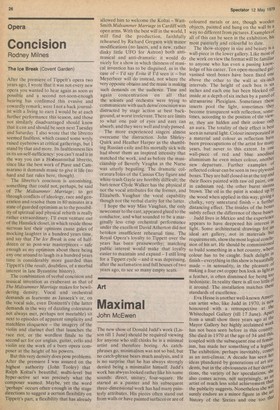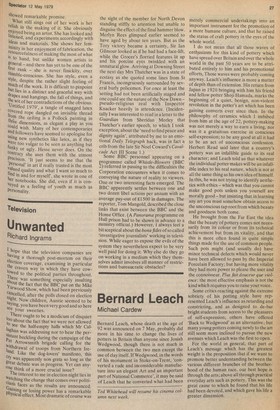Maximal
John McEwen
The new show of Donald Judd's work (Lisson till 1 June) should be required viewing for anyone who still thinks he is a minimal artist and therefore boring. As catchphrases go, minimalism was not so bad, but no catch-phrase bears much analysis, and it is no surprise that he has always strongly denied being a minimalist himself. Judd's work has alwyas looked rather like his name sounds: direct, unitary, four-square. He started as a painter and his subsequent three-dimensional work has had many painterly attributes. His pieces often stand out from walls or have painted surfaces or are of coloured metals or are, though wooden objects, painted and hung on the wall In a way no different from pictures. Examples of all of this can be seen in the exhibition, his most painterly and colourful to date.
The show-stopper in size and beauty is a wall-piece in the lower gallery. Like most of the work on view the format will be familiar to anyone who has even a passing knowledge of his career. Ten open-mouthed galvanised steel boxes have been fixed one above the other to the wall at six-inch intervals. The height of each box is sot inches and each one has been blocked Of inside at a depth of six inches by a panel of ultramarine Plexiglass. Sometimes these inserts pool the light, sometimes they . become transparent with reflection, sometimes, according to the position of the viewer, they are hidden and their colour only an aura. The totality of their effect is best seen in natural light. Colour incorporated in a material and colour as reflection have been preoccupations of the artist for many years, but never to this extent. In one wall-piece of red and blue anodised aluminium he even mixes colour, another new departure. Further examples of reflected colour can be seen in two plywood boxes. They are half closed-in at the top and their floors painted with raw oil paint, one in cadmium red, the other burnt sienna brown. The oil in the paint is soaked up hY the wood when applied in this way, giving a chalky, very untextural finish — a further distancing effect. The insides of the boxes subtly reflect the difference of these bases. Judd lives in Mekico and the experience appears to have deepened his interest In light. Some architectural drawings for all ideal art gallery, not in materials but requirements, show the most logical conclusion of his art. He should be commissioned to build something in a hot country, where colour has to be caught. Such delight in finish — everything in this show is beautiftlitY, made — in sensuality, in the pleasure 01 making a four cwt copper box look as light as a feather, is often dismissed for being hedonistic. In reality there is all too little of it around. The installation matches the standards of excellence. Eva Hesse is another well-known Arneri‘ can artist who, like Judd in 1970, is novi honoured with a retrospective at the Whitechapel Gallery (till 17 June). APart from a small show three years ago at the Mayor Gallery her highly acclaimed work has not been seen before in this count She died in 1970 at the age of 34 and this, coupled with the subsequent rise of feininism, has made her something of a legend' The exhibition, perhaps inevitably, calves as an anti-climax. A decade has seen her ideas plundered by generations of art Or dents, but in.the obviousness of her derivations, the variety of her speculations, she. also comes across, not surprisingly, as,ar,r1 artist of much less solid achievement tna.'ii the publicity suggests. Nonetheless she Wilt surely endure as a minor figure in the .art history of the Sixties and one too tha What still sings out of her work is her relish in the making of it. She obviously enjoyed being an artist. She has looked and listened, and experiments accordingly with ideas and materials. She shows her femininity in her enjoyment of fabrication, the resourcefulness of making the most of what Is to hand, but unlike women artists in general — and there has yet to be one of the first rank — she is never finickity, over thimble-conscious. She has style, even a Style, despite the rather slight feeling of much of the work. lt is difficult to pinpoint but lies in a distinct and graceful way with drapes and hangings, the fall of things, and the wit of her contradictions of the obvious. Untitled 1979', a tangle of snagged latex covered rope dangled on invisible thread from the ceiling is a Pollock painting in three dimensions, as elegant a play as you could wish. Many of her contemporaries and followers have seemed to apologise for using new synthetics like latex, as if they were too vulgar to be seen as anything but funky or ugly. Hesse never does. On the contrary she uses them with the utmost Precision. 'It just seems to me that the Personal' in art if really trusted is the most valued quality and what I want so much to find in and for myself, she wrote in one of her notebooks. She did, even if it is conveyed as a feeling of youth as much as Personality.



































 Previous page
Previous page